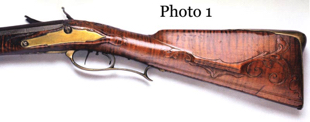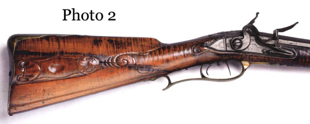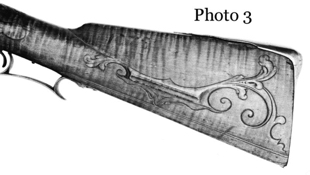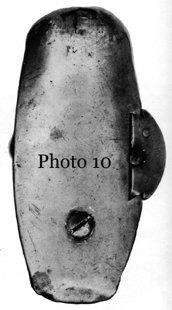Edward Marshall’s Rifle
Prior to engaging in discussion of "Edward Marshall's Rifle," Shumway's rifle number 41 (RCA v.1, 178-181), it would be quite helpful to review a bit of background information concerning Edward Marshall as well as the manner in which this rifle came to be associated with him. While a great deal of attention has been paid to the famous "Walking Purchase" of 1737 in which Marshall was a famed participant and the only man who actually completed the trek, there has been merely one particularly detailed study of his life: William J. Buck's, History of the Indian Walk: Performed for the Proprietaries of Pennsylvania in 1737, to which is appended a Life of Edward Marshall. This book was researched and written ca. 1870-1880 while Buck was employed by the Historical Society of Pennsylvania, and privately published in 1886. Buck was fortunate enough to be researching Marshall's life within ninety years of his death and was able to speak to a number of direct descendants. Most of these interviews occurred ca. 1871-1873. Buck also noted that he was responsible for cataloging the Penn Papers which had been sent to the United States from England ca. 1872-1876, and that he had derived some of his information concerning Marshall and the Walking Purchase directly from this respected, first-hand source. Furthermore, he noted a reliance upon the records of Philadelphia, Bucks and Northampton Counties, and he emphatically stated in his preface that "...chiefly traditionary matter had to be rejected, because so utterly at variance with original existing materials." (Buck 3-4) Buck stated that Marshall's exact date of birth was subject to some dispute, but that it was at some point between the years 1710 and 1715. [He was interviewed by Governor Denny in 1757: "The examination of Edward Marshall of Mount Bethel township, Northampton county, husbandman, aged forty-two years, taken the First day of March, 1757, who being of the people called Quakers..." (Buck 211) This would indicate a birth date of ca. 1715.] Tradition holds that he was born in or near Bustleton, in Philadelphia County [now swallowed by Philadephia's sprawl, near the Northeast Philadelphia Airport], and spent much of his youth near Newtown in lower Bucks County. (Buck 204) Edward and his brothers William and Moses were granted lands above the Tohickon Creek in 1733, this at the time being unsettled territory. By 1738, Marshall was living in Bucks County at what subsequently would become Tinicum; Edward's name, along with those of brothers William and Moses, is found on a petition to the Bucks County Court of Quarter Sessions for 1738 which expressed a desire for the creation of a new township to be called "Tennicunk." (Buck 207) Tinicum, Pennsylvania is along the Delaware River, south of Easton and approximately 2 miles below Frenchtown, New Jersey. That same year - 1738 - Nicholas Scull performed a survey for Marshall for the purpose of mapping approximately 168 acres in what would later [post-1752] become Mount Bethel Township in Northampton County. (Buck 205) This territory was within the bounds of the same lands purchased by the Province of Pennsylvania via the Walking Purchase.
It is not known exactly when Marshall moved to Mount Bethel township in Northampton County, but it may have been in or prior to 1752 at which time - according to Buck - he was paid bounty for a number of wolf and fox hides in Northampton County. His brother John and two nephews (sons of his sister) were already living nearby to the north in Lower Smithfield township as well as a number of his wife's relatives. (Buck 216) I was unable to verify the 1752 payment cited by Buck, however Northampton County Treasurers accounts for 1755 and 1756 indicate a number of payments to Marshall of indeterminate purpose. (HSP MFilmXR 703) By 1755, Northampton County was plunged into chaos as Indians from over the Blue Mountain attacked a number of 'frontier' settlements; the Moravian mission of Gnaddenhutten (approximately 27-28 miles north of Bethlehem and near to the Lehigh River) was attacked on November 24, 1755, and by September, 1757, a list made out by Captain 'Jacob Orndt' noted 114 deaths and 52 people taken prisoner. A letter sent from Easton on Christmas day, 1755, explained that "...the country all above this town for fifty miles is mostly evacuated and ruined, excepting only the neighborhood of Dupue's five families which stand their ground. The people have chiefly fled into Jersey...The enemy made but few prisoners, murdering almost all that fell into their hands, of all ages and both sexes." (Buck 222) In late 1755, Marshall and his family fled to New Jersey likewise and did not return to the farm in Mount Bethel - a few miles below Jacobus [Jacob's] Creek - until the spring of 1757. (Buck 224)
It was approximately May 25, 1757, when Edward Marshall and Matthew Hughes (a former neighbor from Tinicum who was boarding with the family) went up Jacob's Creek to cut logs. While Marshall was working, sixteen Indians attacked his home; the children hid in the woods, but his eldest daughter Catharine (14 years old) was shot while fleeing. Catharine survived but Marshall's wife, purported to be eight month's pregnant, was taken captive, killed and scalped. (Buck 225) This story can be verified in a deposition which was taken at Easton approximately one month later on June 20: George Ebert, sixteen years of age, testified that he had been captured on or about May 2 when a wagon train which he was accompanying was attacked. These wagons were loaded with provisions being sent from Plainfield township to the residents of Lower Smithfield township. Ebert was taken north towards the upper Susquehanna region but soon escaped. He eventually made his way to "French Margret's on the Dishogo," where he stayed for approximately three or four weeks with "friend Indians" [Moravian?] who were kind and who told him that "Marshall's wife had been killed by raiding Indians at the First Mountain [Blue Mountain]." (HSP MFilmXR 703) Later that same year, probably late August, Edward's eldest son Peter was shot and killed in a second Indian attack. (Buck 226) A year later, in late 1758, Edward Marshall married his second wife Elizabeth Wiser/Weiser who was purportedly the daughter of Nicholas Wiser of Chestnut Hill Township, he having been killed during an attack in 1755. (Buck 227) [While some sources note the maiden name of Marshall's second wife as Meaze or Mease, this can be proven to be false. Marshall and his wife had apparently retained land in Northampton County after their subsequent move back to Bucks County (see below), and following Edward's death a deed poll (a form of release) can be found in Northampton County deed book H1, page 156; Elizabeth Marshall of Tinicum township, Bucks County, widow of Edward Marshall, deceased, surrendered all right and title to 133 acres in Chestnuthill township to her brother Nicholas Weiser (jr.) of "Cherre Valle" (Cherry Valley), New York. The deed poll specifically mentioned that the land had belonged to Elizabeth's father Nicholas Weiser. February 6, 1792.] Buck next goes into some detail (230-234) explaining his desire to sift through the many stories of Edward Marshall thence initiating a murderous and lifelong retribution against the Indians, a revenge for the deaths of his first wife and eldest son. It is true that there were bounties being offered for Indian scalps: Buck quotes a number of exploratory letters penned by Edward Shippen, William Peters, Benjamin Franklin, Richard Peters, Thomas Penn and Conrad Weiser which then culminated with Governor Robert Hunter Morris issuing a proclamation in April, 1756, which offered various bounties for male or female captives taken alive as well as male and/or female scalps. This policy was further reinforced in July, 1764, when Governor John Penn essentially reiterated a similar proclamation. (Buck 235) The residents of the 'backcountry' were variously noted as being possessive of a particularly vicious enmity towards the Indians. All that Buck was able to determine as to the truth of Marshall's hatred was as follows:
"Edward Marshall is represented by his descendants as rather taciturn, or having very little to say respecting Indian exploits. One of the daughters of Martin Marshall [in other words, one of Edward Marshall's granddaughters] informed us over thirty years ago [ca. 1840] that her father had said that on one occasion he had pressed him [Edward] to relate his adventures with the Indians. After musing a few seconds, the only reply was, when he discovered an Indian he would shut one eye and they would not meet again."
(Buck 237)
On August 18, 1757, Edward's brother William (of Tinicum) made his will and died soon after. William left all of his estate to his wife Ann to be used as she saw fit for three years, after which all of his lands were to pass to his brother Edward [ca. 1760]. This included Tinicum Island, a large island in the middle of the Delaware River directly across from the mouth of Tinicum Creek and upon which Edward would subsequently make his home; this island would thus come to be known for many years thereafter as "Marshall's Island." (Buck 239) There is no known exact date for the point at which Edward Marshall returned to Bucks County, but according to the terms of William's will, Edward would have full use of William's lands as of approximately August , 1760.
Buck states that he interviewed one of Edward's granddaughters who stated that the first two children by his second wife were born at Tinicum. These would be sons Peter [named for his eldest son, Peter, who had been killed in 1757 - see above] and Thomas. Thomas was born January 19, 1761, which would indicate a birth date for Peter sometime ca. 1759. (Buck 240) He married his second wife in 1758, and in that year he was enumerated upon a 'Horse and Wagon Census' of Northampton County, wherein "Edward Marshell" in Mount Bethel Township is noted as owning two pack horses. (5 PA Archives I, 211) However, the following year [1759], "Edward Mershal" is noted upon the assessment list for Plumstead Township in Bucks County; Plumstead is immediately to the south of and borders upon Tinicum Township. It is possible that Edward was permitted by his sister-in-law to relocate upon William's lands prior to the three-year lapse mandated by William's will, but it is more likely that he had retained land of his own in the area - certainly in Plumstead, as per the tax entry, and possibly also in Tincum and/or Bedminster Townships as well. In fact, Marshall can be placed in Tinicum very shortly thereafter, for in the Pennsylvania Gazette of July 9, 1761, the following advertisement was placed:
"CAME to the Plantation of Edward Marshall, in Tinicum Township, Bucks County, a black Horse, about 8 Years old, shod before, about 13 Hands and an Half high. The Owner coming and proving his Property, and paying the Costs, may have him again."
Less than a year later, another advertisement was placed on January 7, 1762:
"To be sold by the Subscribers, THE following settled Plantations and Tracts of Land, in Tinicum Township, Bucks County, in Pennsylvania, about Thirty five or Forty Miles from Philadelphia, lying on and near the River Delaware... Likewise to be leased, a Farm, containing 302 Acres, well improved, now in Possession of Edward Marshall."
(Pennsylvania Gazette)
All that can be said with a fair degree of certainty, then, is that sometime between the taking of the Northampton County 'Horse and Wagon Census' of 1758 and the 1759 Plumstead Township [Bucks Co.] tax assessment, Marshall removed from Mount Bethel Township back to Bucks County and was located in Tinicum by 1761. I have not uncovered any additional evidence to further clarify this matter.
The only other known documentation regarding Edward Marshall is that he took the Oath of Allegiance on November 30, 1777 (Buck 240), and died November 7, 1789. According to his own account, he was seventy-four years old which would again indicate a birth date of 1715. His tombstone was not erected until 1829, upon which his date of birth is given as 1710, however the intervening span of forty years would tend to explain the error. (Buck 242) On page 243, Buck states that "His estate was settled by Thomas Marshall and Thomas Tillyer and an appraisement made of his personal property by Nicholas Wyker and John Neis on the following 23rd of December, amounting to 749 pounds, 1 shilling 9 pence. In this was...2 guns..." Supposedly Edward's son William (II) either received the pieces directly or bought the two guns at the estate sale, William remaining unmarried and living for many years in Tinicum with his brother Martin. William died in 1823, and his will [which was dated 1821] stated that "My rifle and shot gun with their accoutrements I give to William Marshall..." This would be indicating his nephew William (III), son of his brother Moses (II). (Buck 259) At this point, following the trail of the two firearms becomes a bit more confusing. Moses Marshall (II) died in 1828, and his sons William (III, noted as being the inheritor of the two guns) and Martin (II) moved to Ohio sometime after 1828. This information was apparently acquired early in Buck's interview process, and he notes that it was assumed that the guns were still in the possession of William's descendants. (Buck 260) However, Buck - who was operating in Bucks County at the time he was compiling the information - went on to interview the descendants of Edward Marshall's daughter Catharine [the daughter who was shot in 1757]. Catharine Marshall married a man named William Ridge who was a carpenter from Bensalem, Bucks County, Pennsylvania. To Catharine and William Ridge was born a son named Moses Ridge, and he subsequently was the father of twin sons Thomas and William Ridge (II). These two men were Edward Marshall's great-grandsons and had lived their entire lives in Tinicum. (Buck 262) William Buck interviewed these two men in 1873 and notes the following:
"The aforesaid brothers are the present owners of a rifle that is said to have belonged to Edward Marshall, made at Rothenberg, Germany, and was purchased at the sale of Martin Marshall's effects. [Martin being a son of Edward, and with whom William Marshall - who had owned the two rifles and willed them to his nephew William III - lived prior to his death.] It is a flint-lock, and has the appearance of having seen considerable service though still in good order. The barrel is three feet one and a half inches in length, and the bore five-eighths of an inch in diameter with six grooves. It's total weight is nine and three-fourths pounds, and carries an ounce ball, which is sufficiently large to prove destructive."
(Buck 265)
This is quite interesting and presents something of a puzzle. Based upon the description, there can be no doubt that the rifle being described is the same rifle donated to the Bucks County Historical Society by Edward Marshall Ridge in 1922 and illustrated in Shumway as RCA 41. Another mention of the rifle is found ca. 1900 in a paper presented by W.W.H. Davis before the Bucks County Historical Society based upon the research of Donald Repsher:
"As Marshall could not get a rifle in this country to suit him, he caused a barrel and lock to be purchased in Germany which he had mounted here. I have seen and handled this famous piece. On top of the barrel are the following letters, faintly seen: 'I.A.D. Rosenberg.' The rifle is still in the family, and when I saw it, some years ago, the hair trigger was as sensitive to the touch as when the original owner set it to shoot Indians over 150 years ago. In the flint-box was the identical rammer screw that Marshall used in cleaning it before starting out in search of human game. It is doubtful whether any other firearm in existence has shed so much human blood as this old rifle."
(Davis/Repsher 615)
There is certainly a fair measure of the "chiefly traditionary matter" criticized by William Buck [see above] present within this statement, however the comment regarding the importation of the lock and barrel from Germany and the stocking of the rifle here is quite interesting. There is no reason for Davis and Repsher [writing long before Dillin's 1927 groundbreaking book and the study of the American longrifle was taken seriously] to assume that the rifle was not a German rifle, as many of the earliest collectors of the 'Kentucky Rifle' assumed that curly maple was commonly utilized in Europe as well. It is likely that this story originated with the family and was oral tradition; unfortunately it is not possible to investigate this angle any further. [It should be mentioned that the other gun purported to have belonged to Edward Marshall and mentioned in his will was illustrated by Gene Miller in an article, "Edward Marshall and His Participation in the Famous Indian Walk," which has been reprinted in the book Selected Articles from the KRA Bulletin pages 530-533. This fowler had supposedly descended within the Hinkle family, they being descendants of Marshall's daughter Rebecca.]







